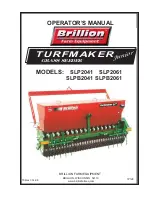
4. Remove the seed tubes from the lower bar and attach bags to the ends to allow the
material to be collected.
5. Move the calibration handle located in the rear of the hopper to a position between
0.5 and 6.
6. Drive the tractor forward pulling the machine along the predetermined distance. It is
important for the cultipacker to remain on the ground at all times and to roll
continuously.
7. Collect all material distributed and weigh.
8. Using
Table 3
determine the amount of material distributed.
Example: If the
distance traveled is 100 ft. and 0.1 lb. of material is collected, then 9.2 lb. per
acre of material is being distributed.
9. If the results do not correspond to the amount that needs to be distributed, adjust the
calibration handle accordingly.
3.07 - Start Up
DANGER: Never allow anyone around the Command Seeder when it is in
operation.
CAUTION: Before starting work, clear the area of any obstacles or foreign objects
and make sure that the rear cultipacker locking pins have been removed (see fig.
5).
Start out with the tractor in the lowest gear, increase gears slowly if necessary.
Avoid working in reverse.
Before beginning work always remember that the operator is responsible for:
1. Safe and correct operation of the tractor and Command Seeder.
2. Learning and following precise, safe operating procedures for both the tractor and
the Command Seeder.
3. Ensuring all maintenance and lubrication has been performed on the Command
Seeder.
4. Having read and understood all safety aspects for the Command Seeder in the
operator’s manual.
5. Having read and understood all safety decals on the Command Seeder.
6. Checking that there are no wires, weeds, grass or other objects wrapped around the
cultipackers.
7. Checking to see if front weights need to be added to the tractor in order to maintain
balance.
8. Checking the tractor tires for the proper pressure in accordance to the tractor
operator’s manual.
O
PERATION
18
ABI A
TTACHMENTS
C
OMMAND
S
EEDER
O
PERATOR
’
S
M
ANUAL


































